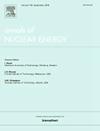Investigation of the impact of rotor- stator matching modes on the pressure pulsations of the guide vane centrifugal pump
IF 1.9
3区 工程技术
Q1 NUCLEAR SCIENCE & TECHNOLOGY
引用次数: 0
Abstract
The main source of intense pressure pulsation during the operation of a guide vane centrifugal pump is the rotor–stator interaction, which is directly related to the matching modes of the impeller and guide vane. In order to grasp the influence of different impeller/vane matching modes on the pump pressure pulsation, this study designs three different guide vanes and investigates the complex pressure pulsations through experimental tests. Besides, the complex internal flow structure of the pump is also explored based on the numerical computation means of DDES to reveal the typical flow field of this type of centrifugal pump. The findings of the experiment demonstrate that the blade passing frequency remains the dominant frequency in the pressure pulsation spectrum even under various rotor–stator matching modes. The DY8 and DY9 pumps are shown to be able to significantly reduce the pressure pulsation energy caused by rotor–stator interaction at the design and high flow conditions based on the amplitude of the blade passing frequency and the RMS value within the 0–1000 Hz frequency region. The impeller output surface forms a notable jet-wake flow pattern, as seen by the numerical findings, which also characterize the high and low flow zones. Both the guide vane and the impeller create typical vortical structures, and as the impeller rotates, the impeller’s vortex will interact with the guide vane. Choosing a larger number of guide vane blades during the pump design is advised in light of the decreased rotor–stator contact.
求助全文
约1分钟内获得全文
求助全文
来源期刊

Annals of Nuclear Energy
工程技术-核科学技术
CiteScore
4.30
自引率
21.10%
发文量
632
审稿时长
7.3 months
期刊介绍:
Annals of Nuclear Energy provides an international medium for the communication of original research, ideas and developments in all areas of the field of nuclear energy science and technology. Its scope embraces nuclear fuel reserves, fuel cycles and cost, materials, processing, system and component technology (fission only), design and optimization, direct conversion of nuclear energy sources, environmental control, reactor physics, heat transfer and fluid dynamics, structural analysis, fuel management, future developments, nuclear fuel and safety, nuclear aerosol, neutron physics, computer technology (both software and hardware), risk assessment, radioactive waste disposal and reactor thermal hydraulics. Papers submitted to Annals need to demonstrate a clear link to nuclear power generation/nuclear engineering. Papers which deal with pure nuclear physics, pure health physics, imaging, or attenuation and shielding properties of concretes and various geological materials are not within the scope of the journal. Also, papers that deal with policy or economics are not within the scope of the journal.
 求助内容:
求助内容: 应助结果提醒方式:
应助结果提醒方式:


